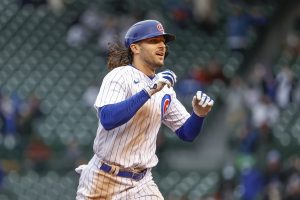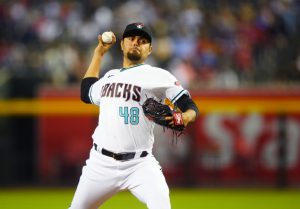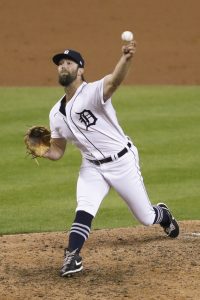Last week’s trades of Anthony Rizzo, Javier Baez, and Kris Bryant were painful for Cubs fans. Rizzo had been a Cub for 9.5 years. Baez was drafted by the Cubs and his tenure lasted a decade. Bryant was with the team for eight years after being drafted. By 3pm Friday, all three were in different uniforms. We can debate separately why it came to this, but today the question is, where do the Cubs go from here?
Let’s take stock of what the Cubs currently have at each position.
Catcher
Willson Contreras, 29, is under team control through 2022. As Contreras put it recently, “This is the only team I’ve played for, and if they want to rebuild around me, I’m happy to talk.” Given GM Jed Hoyer’s frustration in failing to lock up Rizzo, Baez, and Bryant, the Cubs may not necessarily be able to match up with Contreras, in which case an offseason trade would make sense.
22-year-old Miguel Amaya, the heir apparent, currently sports an odd Double-A batting line of .215/.406/.304. FanGraphs’ Eric Longenhagen recently downgraded Amaya to a 45 grade, on account of a relative lack of power. He hasn’t played since June 3rd due to an injury.
There are no franchise catchers in the 2021-22 free agent class, so the Cubs have all of 2022 to figure out if their future starter behind the dish will be Contreras, Amaya, or neither.
First Base
Rizzo was a mainstay at first base for the Cubs since 2012, but he was traded to the Yankees last Thursday. Last March, Ken Rosenthal and Patrick Mooney of The Athletic reported the Cubs offered him a five-year, $70MM extension. Technically, the Cubs could bring Rizzo back in the offseason, but that will probably only happen if he finds the open market terribly disappointing. And even in that case, he may prefer to play for a team with a better shot at reaching the playoffs.
In Rizzo’s absence, Patrick Wisdom has been playing first base for the Cubs. Wisdom, who turns 30 later this month, owns a 142 wRC+ in 186 plate appearances this year. More time will be needed to determine whether Wisdom is a valuable late bloomer, or if he’s a journeyman having a good couple of months. Wisdom is nowhere near free agency and won’t even be arbitration eligible until after 2023, so the Cubs can afford to give him regular playing time in 2022. He’s played more third than first base, so that could be his ultimate spot. The Cubs could also take a look some point at Alfonso Rivas, who has a 130 wRC+ at Triple-A despite modest power.
This winter the Cubs could hit the market for a veteran placeholder in the mold of Brandon Belt or C.J. Cron, if they decide to play Wisdom mostly at third base in 2022.
Second Base
The Cubs were surprisingly able to land Nick Madrigal from the White Sox for Craig Kimbrel in one of their trade deadline deals. Madrigal, 25 in March, is under team control through 2026. He’s out for the season due to a torn hamstring, but figures to be a mainstay in the Cubs’ lineup for years.
Shortstop
In 2019, Baez settled in as the Cubs’ everyday shortstop, a year after he finished second in the MVP voting. He was a fan favorite, but again, the Cubs couldn’t find common ground on a contract extension. Baez was traded to the Mets, where he’ll play shortstop until Francisco Lindor returns from an injury, and then switch to second base to finish out the season alongside his friend.
Last April, Jon Heyman of MLB Network reported that in spring 2020, the Cubs offered Baez a contract in the range of $160-170MM. ESPN’s Buster Olney suggested the $180MM range. That’s not an amount I expect Baez to approach in free agency this winter, especially with significant competition at shortstop. This is a case where the Cubs keeping the door open to a reunion could potentially matter, but like Rizzo he’d still have to experience a disappointing market first. The lack of a collective bargaining agreement could further complicate matters.
Under the Theo Epstein regime, the Cubs were not opposed to making a free agent strike if they liked the player, even if their perceived competitive window was not yet open. The idea worked poorly with Edwin Jackson, and well with Jon Lester. In that sense, it wouldn’t be crazy to see the Cubs make a run at one of the jewels of the 2021-22 free agent class, Corey Seager or Carlos Correa. Both are young enough that if 2022 and ’23 turn out to be rebuilding years for the Cubs, they’d still have a portion of the player’s prime. The players might require a premium to enter into a rebuilding situation.
On the other hand, the Cubs’ $126MM deal for Yu Darvish will be nearly three years in the past when free agency opens, and the Ricketts family has not been flexing financial muscle in the interim. The Cubs have only about $40MM committed to the 2022 payroll, with Jason Heyward, Kyle Hendricks, and David Bote.
Barring an unlikely major free agent signing, the Cubs’ future at shortstop involves Nico Hoerner and Ed Howard. Hoerner figures to play the position in the immediate future. Howard, who the Cubs drafted 16th overall out of high school last summer, might be the long-term answer. Cristian Hernandez may be in that discussion as well, but both teenagers are several years away.
Third Base
Wisdom and Bote should be in the mix for the Cubs at the hot corner next year, with Matt Duffy headed to free agency. Prospect Christopher Morel hasn’t done much with Double-A pitching so far this year, but if he figures it out he’ll enter the third base picture. Even if Wisdom works out as a big league regular, the Cubs will be lacking at whichever infield corner he doesn’t play. The free agent market doesn’t offer any exciting players, aside from Bryant.
Left Field
Ian Happ has drawn the Cubs’ left field assignment of late, though he’s having an abysmal year. Making $4.1MM through arbitration this year, he won’t get much of a raise this winter, so the Cubs can afford another year to see if he can regain his hitting stroke. A stopgap veteran addition would also make sense, with free agency featuring Andrew McCutchen, Tommy Pham, Mark Canha, and even players the Cubs have already tried like Kyle Schwarber and Joc Pederson.
Center Field
The Cubs are well-covered here, as prospect Brennen Davis was recently ranked 30th in the game by Baseball America. Davis is playing well at Double-A this year, with a .267/.383/.515 line. BA has suggested he may eventually move to right field, and at Double-A he’s spent more time in center but a fair bit in right. You can safely pencil Davis in at one of those two spots – probably in late April next year once he’s done “working on his defense” (wink, wink).
Meanwhile in the Majors, with Happ struggling and Jake Marisnick traded, Rafael Ortega is attempting to win the Cubs’ regular center field job. After a recent home run binge, the 30-year-old is up to a 144 wRC+ in 123 plate appearances. Like Wisdom, it’s too early to say whether Ortega will establish himself as an above average big leaguer. But the Cubs are in good position to let Ortega try for the rest of the year, and into 2022 if it goes well.
Right Field
With a 63 wRC+ this year, Jason Heyward’s offense has been reminiscent of his first year with the Cubs, when he surprisingly slumped to a 72 mark. If his struggles persist, the Cubs are going to have better uses of the playing time. Heyward is owed $44MM from 2022-23. He remains the one large contract on the Cubs’ books, but only two years remain.
Greg Deichmann, who joined the Cubs in the Andrew Chafin trade with Oakland, is a name to watch in the team’s right field mix. He posted a .433 OBP for the Triple-A Las Vegas Aviators and should be in the Majors soon. The Cubs have a slew of other outfield prospects in the system, but most of them are further away.
Starting Rotation
Kyle Hendricks continues to be the rock of the Cubs’ rotation. The low-key veteran can be retained through 2024 if the Cubs pick up his club option. While Hendricks could be traded this winter, the 31-year-old soft-tosser could also be part of the next Cubs contender. Hendricks seems like he’ll age gracefully, since he’s not dependent on velocity.
Adbert Alzolay has shown enough to have a rotation spot locked down for next year. He’s got a 4.85 ERA in 19 starts, which isn’t great, but he probably won’t continue to see a quarter of his flyballs leave the yard. Alzolay’s struggles against left-handed hitters have been pronounced, however: 19 home runs in 196 batters faced. Still, the bar is pretty low to be in the Cubs’ 2022 rotation. Alec Mills will still be around next year to fill a swingman role.
Justin Steele and Keegan Thompson are being stretched out for looks in the Cubs’ rotation down the stretch. These are not pitchers the prospect hounds get particularly excited about, but the Cubs have plenty of opportunity for anyone who can capitalize. Prospect gurus do get excited about Brailyn Marquez, who Baseball America ranked as the 99th-best prospect in the game. However, the 22-year-old has yet to pitch this year due to a shoulder strain. Caleb Kilian, acquired in the Bryant deal, has pitched well at Double-A, so we could see him in the Majors relatively soon.
As it stands now, the Cubs simply don’t have the pitching in-house to get through the 2022 season, let alone compete. It’s a rotation ripe for opportunistic free agent signings, a place where guys like Dylan Bundy or James Paxton can look to get their careers back on track before getting flipped for prospects.
Bullpen
The Cubs’ bullpen has been stripped of its three highest-leverage relievers: Kimbrel, Ryan Tepera, and Andrew Chafin. Codi Heuer, acquired in the Kimbrel deal, will take a spot. Beyond him, I assume the Cubs will look to replicate one of their few successes of the previous offseason: the signings of Tepera and Chafin for a total of $3.55MM. The goal will be to sign another batch of veteran relievers, coax good first halves out of them, and trade them for prospects at the deadline.
Conclusion
After all the star players were purged, the Cubs are frankly low on present talent. For 2022, they’ve got massive holes throughout their lineup and pitching staff. Their farm system has Davis plus various interesting players, but it’s not teeming with blue-chip prospects like the Rays, Mariners, Blue Jays, or Tigers. Given their market size, it doesn’t seem like the Cubs should be dropping down to a bottom-10 payroll in the game. But an analysis of the roster and farm system suggests the Cubs cannot spend their way back into contention, at least not in the 2021-22 offseason alone. Last time it was a three-year rebuild, and to contend again with anything less will be a difficult or expensive feat.



